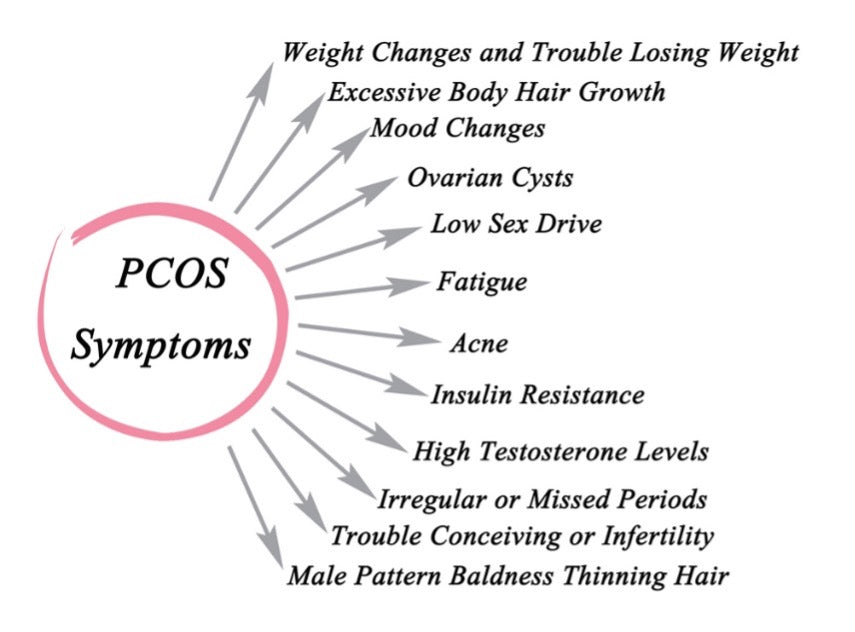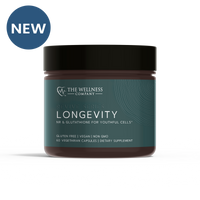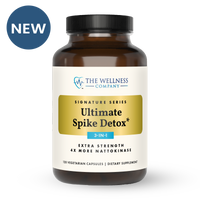Manage Your PCOS Naturally - Here’s How

What is PCOS?
PCOS is a complex endocrine condition characterized by irregular menstrual cycles, elevated androgen levels, and polycystic ovaries. It is associated with reproductive, metabolic, and psychological issues.
Symptoms
- Irregular or no periods at all
- Irregular ovulation leads to difficulty getting pregnant
- Excessive hair growth, especially on the face, chest, back or buttocks
- Mood changes
- Excessively tired
- Weight gain, trouble losing weight
- Thinning hair and hair loss from the head
- Oily skin or acne
Prevalence
The prevalence of PCOS varies depending on the diagnostic criteria used, but it is estimated to affect about 6-22% of women of women of reproductive age globally. Most women are diagnosed in their 30s. (1)
Risk Factors
Risk factors for PCOS include:
- Genetics and family history
- Obesity
- Insulin resistance
- Type 1 diabetes, type 2 diabetes, or gestational diabetes

Causes
The exact cause of PCOS is unknown, but it is believed to involve a combination of genetic and environmental factors. (1)
Key factors thought to play a role include:
- Hormonal imbalances (elevated total and free testosterone and insulin)
- Insulin resistance
- Obesity
- Low-grade inflammation
- Genetic predisposition
Role of Insulin Resistance in PCOS
Insulin resistance is when cells in the muscles, fat, and liver don’t respond well to insulin and can’t easily take up glucose from the blood. Insulin resistance increases the risk of type 2 diabetes. (2)
Insulin resistance plays a central role in PCOS pathophysiology:
- It affects 70 % of women with PCOS
- This leads to compensatory hyperinsulinemia (more insulin being made but the body is unable to use it)
- Excess insulin stimulates ovarian androgen(testosterone) production. Insulin can bind to insulin-like growth factor receptors in the ovaries, leading to increased androgen production. (2)
- Creates a vicious cycle of worsening PCOS symptoms and metabolic issues.
- This contributes to weight gain, which further exacerbates insulin resistance.
How to naturally manage PCOS

While there is no one-size-fits-all all to resolve PCOS, there are many ways to help manage PCOS.
Most women who have PCOS also have insulin resistance resulting in high androgen levels, namely testosterone, getting to the root cause of insulin resistance may help manage symptoms.
The objective is to lower insulin. By lowering insulin testosterone levels should decrease, breaking the vicious cycle contributing to PCOS.
This can be accomplished through diet, exercise and stress reduction techniques, along with appropriate supplementation. Consult with your healthcare provider before embarking on any new diet or exercise regimen.
Basically, lowering insulin involves
- Reduce carbohydrate intake. Limit or eliminate grains, and increase non-starchy vegetables.
- Increase good fats and clean protein sources. Olive oil, coconut oil, grass-fed butter, grass-fed and finished beef, organic pasture raised chicken, and wild-caught cold-water fish such as salmon, tuna, and sardines are good choices.
- If overweight work on losing weight through diet and exercise. If you haven’t been regularly exercising, aim for 30-minute walks at a leisurely pace, gradually increasing time, pace, and distance 5-6 times a week.
- Reduce stress through meditation, yoga, or prayer practices. Stress increases cortisol levels, which in turn elevates blood sugar, which can eventually lead to increased insulin levels and eventually diabetes.
Effective, targeted supplementation to help reduce insulin levels through glycemic control is found in our robust formula:

Proven, research-backed ingredients that are gluten-free, vegetarian and proudly made in the U.S., Peak Metabolism will help you reach your weight loss goals and help improve glycemic control.
- Chromium
An essential mineral that works with insulin to help regulate blood sugar levels. (3)
- Turmeric
Some studies indicate that turmeric can help reduce glucose levels and may help with insulin resistance. In addition, it is widely known as an anti-inflammatory. (4)
- Berberine
Widely known for its ability to reduce insulin resistance, berberine has shown promise in increasing good cholesterol and has exhibited therapeutic effects in regulating metabolism. (5)
- Bitter melon extract
Rich in vitamins A, B1, B2, B9, C, and E, along with calcium, potassium zinc, and more, bitter melon is packed full of health promoting nutrients. It also has shown promise in lowering glucose levels. (6)
- Alpha-lipoic acid
A water- and fat-soluble antioxidant with the ability to improve insulin sensitivity and shows promise in relieving symptom relief of diabetic neuropathy. (7)
- Cinnamon Cassio extract
Known for its ability to relieve gastric distress (flatulence, nausea, and vomiting), it works to improve blood sugar control. In addition, cinnamaldehyde and other naturally occurring chemicals have antibacterial and antifungal properties. (8)
- Liposomal Banaba Extract
Banaba extract has been studied as far back as 1940. Its active ingredient, corosolic acid has been reported to decrease blood sugar levels and regulate lipid metabolism. Its leaves are rich in compounds that possess antioxidant, antifungal, antiviral, and anti-inflammatory properties. In addition, it also shows promise in helping build and heal bones.
In liposomal form, Banaba extract is protected against the harsh environment of the GI tract and is delivered and absorbed more efficiently. This means more of the active compound is delivered where it needs to be in the body. (9)
- Black pepper
The active ingredient in black pepper, piperine, increases the absorbability of supplements that it is used with. especially turmeric. This means that you will absorb as much of the active ingredients possible in a natural form. (10)
References
- Deswal R, Narwal V, Dang A, Pundir CS. The Prevalence of Polycystic Ovary Syndrome: A Brief Systematic Review. J Hum Reprod Sci. 2020 Oct-Dec;13(4):261-271. doi: 10.4103/jhrs.JHRS_95_18. Epub 2020 Dec 28. PMID: 33627974; PMCID: PMC7879843.
- Pateguana NB, Janes A. The contribution of hyperinsulinemia to the hyperandrogenism of polycystic ovary syndrome. J. insul. resist. 2019;4(1), a50. https://doi.org/10.4102/jir.v4i1.50
- Office of Dietary Supplements. (n.d.). Chromium: Fact sheet for health professionals. National Institutes of Health. https://ods.od.nih.gov/factsheets/Chromium-HealthProfessional/
- Ghorbani, Z., Hekmatdoost, A., & Mirmiran, P. (2014). Anti-hyperglycemic and insulin sensitizer effects of turmeric and its principle constituent curcumin. Journal of Endocrinology and Metabolism, 12(4), 1-10. https://doi.org/10.1007/s00203-014-0998-7
- Ye Y, Liu X, Wu N, Han Y, Wang J, Yu Y, Chen Q. Efficacy and Safety of Berberine Alone for Several Metabolic Disorders: A Systematic Review and Meta-Analysis of Randomized Clinical Trials. Front Pharmacol. 2021 Apr 26;12:653887. doi: 10.3389/fphar.2021.653887. PMID: 33981233; PMCID: PMC8107691.
- Kim B, Lee HS, Kim HJ, Lee H, Lee IY, Ock S, Kwon S, Kang SS, Choi Y. Momordica charantia (bitter melon) efficacy and safety on glucose metabolism in Korean prediabetes participants: a 12-week, randomized clinical study. Food Sci Biotechnol. 2022 Dec 14;32(5):697-704. doi: 10.1007/s10068-022-01214-9. PMID: 37009042; PMCID: PMC10050654.
- Mount Sinai. (n.d.). Alpha-lipoic acid. Retrieved from https://www.mountsinai.org/health-library/supplement/alpha-lipoic-acid
Ruyuan Zhu, Haixia Liu, Chenyue Liu, Lili Wang, Rufeng Ma, Beibei Chen, Lin Li, Jianzhao Niu, Min Fu, Dongwei Zhang, Sihua Gao,
- Cinnamaldehyde in diabetes: A review of pharmacology, pharmacokinetics and safety,Pharmacological Research, Volume 122,2017,Pages 78-89,ISSN 1043-6618,https://doi.org/10.1016/j.phrs.2017.05.019.
- Miura T, Takagi S, Ishida T. Management of Diabetes and Its Complications with Banaba (Lagerstroemia speciosa L.) and Corosolic Acid. Evid Based Complement Alternat Med. 2012;2012:871495. doi: 10.1155/2012/871495. Epub 2012 Oct 2. PMID: 23082086; PMCID: PMC3468018.
- Kesarwani K, Gupta R, Mukerjee A. Bioavailability enhancers of herbal origin: an overview. Asian Pac J Trop Biomed. 2013 Apr;3(4):253-66. doi: 10.1016/S2221-1691(13)60060-X. PMID: 23620848; PMCID: PMC3634921.
Written By Brooke Lounsbury














